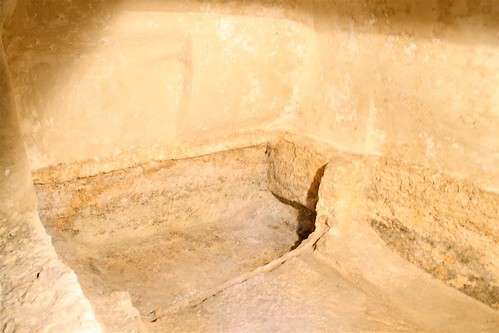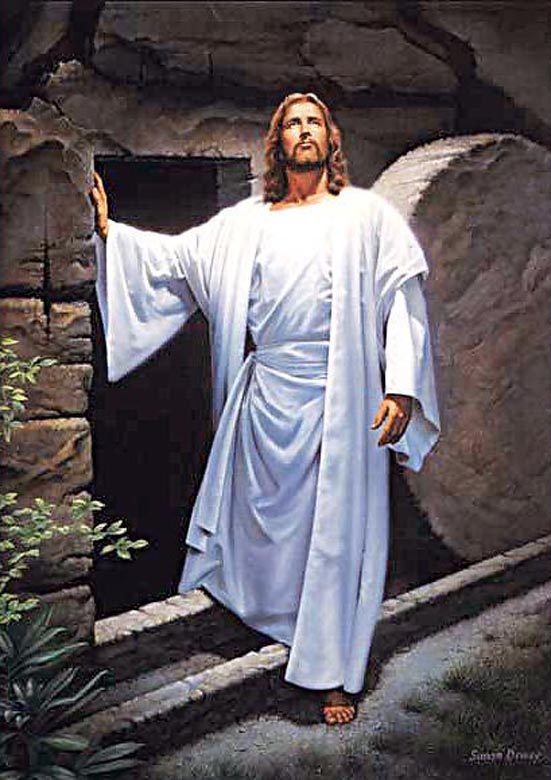 The resurrection of Jesus is supported by three pillars: the empty tomb, the postmortem appearances, and the birth and growth of the church in the face of severe persecution. In order to undermine the historical support for the resurrection, a naturalistic theory has to explain all three in a way that is scientifically and psychologically viable and not excessively ad hoc.
The resurrection of Jesus is supported by three pillars: the empty tomb, the postmortem appearances, and the birth and growth of the church in the face of severe persecution. In order to undermine the historical support for the resurrection, a naturalistic theory has to explain all three in a way that is scientifically and psychologically viable and not excessively ad hoc.A greater assortment of sledge hammers have been taken to the empty tomb than either of the other two pillars, but even so, most critical scholars accept its historicity. Jewish scholar Geza Vermez concludes: "But in the end, when every argument has been considered and weighed, the only conclusion acceptable to the historian must be that the opinions of the orthodox, the liberal sympathizer and the critical agnostic alike . . . are simply interpretations of the one disconcerting fact: namely that the women who set out to pay their last respects to Jesus found to their consternation, not a body, but an empty tomb."
But some skeptics try to characterize the story of the empty tomb as legend, so I will start by addressing the historicity of the empty tomb.
Is the empty tomb a legend? Skeptics argue that, unlike 1 Corinthians, the Gospels were written by anonymous authors at least thirty years after the death of Jesus, so enough time passed for legendary embellishment to develop. But there are three major reasons why the empty tomb is not a legend:
First, according to the late historian of ancient Rome and fellow at Oxford, A. N. Sherwin-White, "even two generations are too short a span to allow the mythical tendency to prevail over the hard historic core of the oral tradition." And with respect to historical reconstruction, he says that "we are seldom in the happy position of dealing at only one remove with a contemporary source." But the first Gospel was written while many of the original eyewitnesses were probably still alive. So that is not enough time for legend to have replaced the historical core of the stories of which the Gospels are composed.
Sherwin-White is one of a number of historians who have confirmed the historicity of the book of Acts "even in matters of detail." And he concludes that the reason why the "degree of confirmation in Graeco-Roman terms is less for the Gospels than for Acts is due, as these lectures have tried to show, to the differences in their regional setting. As soon as Christ enters the Roman orbit at Jerusalem, the confirmation begins. For Acts the confirmation of historicity is overwhelming" (italics added). So because of the regional setting of most of the Gospel stories, we cannot directly confirm their basic historicity in the way that we can the book of Acts. But since Acts is by all appearances "no less of a propaganda narrative than the Gospels, liable to similar distortions," there is no reason to think that the Gospels are less historical.
Second, in 1 Corinthians 15:3-7, Paul recites a creedal formula which most scholars, including skeptics like Gerd Lüdemann, date to within a couple of years of the death of Jesus, and in it he says, "and that [Jesus] was buried, and that He was raised on the third day according to the Scriptures" (1 Corinthians 15:4). Paul's statement (and by extension, the statement of his predecessors shortly after the death of Jesus) that Jesus was raised on the third day implies that the tomb was empty because otherwise the creed could not have said that Jesus was raised on the third day. If a body remained in the tomb or rotted in a common grave, the day of his resurrection would have been unknown.
The words "according to the Scriptures" do not help here because Hosea 6:2, the Old Testament reference, would be too subtle unless Paul knew of the empty grave on the third day. Hosea 6:2 says "He will revive us after two days; He will raise us up on the third day, that we may live before Him." Unless the early church knew that the tomb was found empty on the third day, it would be too much of a stretch to say that this verse is a Scriptural reference to the day of the resurrection.
This further undermines the theory that the empty tomb was a legend, since the early Christians would have preached it from the very beginning.
Third, critical scholars employ historical criteria to determine whether parts of the Bible are true, and two of them are the criterion of multiple attestation and the criterion of embarrassment. The criterion of multiple attestation is met because the story of women finding the tomb empty is told in each of the four Gospels. (And of course they were not originally part of a compilation labeled the "New Testament." They were the earliest and most reliable documents about Jesus.)
The criterion of embarrassment is met because the male disciples fled in fear after Jesus was arrested, while women, who had virtually no status in first century Palestine, and were not considered reliable witnesses, stayed and went to pay their last respects to Jesus. They were the star witnesses to the empty tomb, something that the authors would be very unlikely to fabricate.
Someone suggested in a previous thread that Mark invented the empty tomb to fill in a gap in his story of what happened to Jesus, and that 16:8 was Mark's way of explaining why the story of the empty tomb had not been told earlier. ("They went out and fled from the tomb, for trembling and astonishment had gripped them; and they said nothing to anyone, for they were afraid.") That is, the "unreliable" women who said nothing were a later invention. However, the context indicates that the women were only silent temporarily because they were terrorized by their experience. In Mark 16:7 the angel tells them to go tell Peter and the other disciples, and in Matthew, Luke, and John they do exactly that. Most likely Mark just left that part out and instead focused on the women's state of mind immediately after their encounter with the angel.
Numerous theories have been put forth over the years of natural explanations for the empty tomb, and I will briefly mention the major ones:
Did the disciples steal the body? Matthew 28:11-15 says that a story of the disciples stealing the body of Jesus circulated among the Jews. Although we don't have independent corroboration that first century Jews made this arguments (but I'm aware of modern Jews who have been given that explanation growing up in Jewish schools), it is unlikely that Matthew invented this, since he brought it up for the purpose of refuting it. If another argument had been widespread among the Jews at the time, why did he not focus on that on instead?
This argument concedes the empty tomb because if there was some way of denying that the tomb was empty in the first place, the detractors of Christianity would have taken that approach. They could have produced a body, argued that the body was one of many in a common grave, or claimed that the story of the empty tomb was invented later. But instead of denying the empty grave, they chose to explain it away.
The stolen body hypothesis has been rejected by modern critics because the disciples would not have been willing to die for a known lie. Something changed the followers of Jesus from doubting cowards to courageous proclaimers of the Gospel who were willing to die for their faith.
Did Jesus not really die? This was a popular hypothesis around the beginning of the nineteenth century, but like the stolen body theory, it has been almost completely abandoned by modern scholars. It states that Jesus did not fully die on the cross and recovered in the tomb. This hypothesis has major problems. First, since Jesus was at least severely wounded from the crucifixion, there is no way He could have removed the stone covering the entrance to the tomb, so the apparent death theory has to be in part conspiracy theory. Second, as the very liberal scholar David Strauss argued, how did a half-dead Jesus stumble into a meeting of His doubting and fearful disciples and encourage them with the news that He had conquered death and someday they would have a body just like His? Third, numerous studies show that medically there is no way He could have survived the crucifixion. Skeptical Jesus Seminar co-founder John Dominic Crossan has stated that the fact that Jesus died by crucifixion is as sure as any fact could ever be.
Did the women visit the wrong tomb? This hypothesis, put forth in the early twentieth century, says that the women lost their way to the tomb and ended up at one that was unoccupied. A caretaker said to them, "You are looking for Jesus of Nazareth. He is not here," and the women were so unnerved that they ran off without hearing the rest of the explanation. When the disciples started talking about appearances of the risen Christ, the women embellished the story into the account found in Mark.
This hypothesis never took off in large part because it cherry picks certain parts of the Gospel account and dismisses others without giving good justification. And it doesn't explain why nobody, including the Jewish leaders, ever set the record straight.
Did Joseph of Arimathea remove the body from his tomb? One hypothesis states that Joseph was not a follower of Jesus, but that Joseph placed Jesus in his rock-hewn tomb in observance of the Jewish laws that a body had to be buried within 24-hours and that burial was prohibited on the Sabbath. Since Jesus died shortly before the start of the Sabbath (from sundown on Friday to sundown on Saturday), there was no time to dig a grave. Joseph temporarily stored the body in his tomb, and then removed it after the Sabbath. The women later discovered the tomb empty.
There are several problems with this explanation: First, since Joseph was a member of the Sanhedrin and a devout Jew, why did he not announce what he had done when the early Christians began proclaiming that Jesus had risen from the dead? He could have done much to nip the movement in the bud. Second, if Joseph had taken the body, there is no reason to think that the followers of Jesus would have concluded that He had risen. According to John 20:2, Mary Magdalene immediately assumed that someone had taken the body of Jesus. Third, Joseph must have removed the body after sundown on Saturday and before dawn on Sunday, which is when the Gospels tell us the women arrived. Why did he not wait until daylight before he removed the body? If he was not sympathetic to Jesus, it seems reasonable that he would remove the body, but it makes no sense that he did it after dark and that he failed to later announce what he had done.
Every naturalistic explanation of the empty tomb has serious problems, and even if they can be overcome, another major hurdle remains: the appearances of Jesus as the risen Christ in such a convincing way that his followers--including those who started out as skeptics--were willing to sacrifice their lives for their faith. The subject of my next post will be the skeptical response to the appearances of Jesus.




